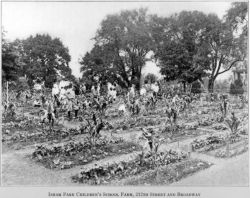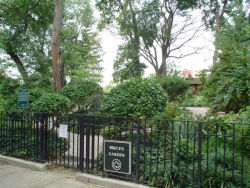Isham Park
Isham Park
Isham Park sits high upon a crest of land, bolstered by the massive protrusion of Manhattan schist that defines the northern end of the island of Manhattan. Remarkable for its far-reaching views of the Hudson and Harlem River valleys, this park was initiated in May 1911 when the first in a series of gifts of land was offered by the Isham family to the city in order to create a public park.
Our knowledge of northern Manhattan owes much to the work of historian and archeologist Reginald Bolton (1856-1942) who uncovered evidence of indigenous planting fields and burial sites within the footprint of present-day Isham Park, as well as the remains of Hessian redoubts from the period of the Revolutionary War (1776-1782). Well before this land became park, its attractions (particularly its elevation) drew Native Americans, colonists, soldiers, and 19th century Americans alike.
In 1864, William Bradley Isham (pronounced ‘EYE-sham’), a successful leather merchant–turned-banker, purchased as a summer residence twenty-four acres with a two-story house, a stable, and greenhouses from the family of Dr. Floyd T. Ferris. The estate was located along the western side of Kingsbridge Road (the northern extension of Broadway) in that part of Manhattan already known as Inwood. The land was graced with rocky outcrops, cold springs, fields and forests, and dramatic vistas of both the Harlem and the Hudson Rivers. Mr. Isham later moved the stable from the top of the hill to its western slope below, and landscaped the area with lawns, trees, and gardens. A former farmer when he lived upstate, he was also known to have planted wheat on this land at one time.
In 1911, in the wake of Mr. Isham’s death, his daughter, Julia Isham Taylor, donated a six-acre portion of his estate to the city to be named in remembrance of him. In 1912, Julia’s aunt Flora E. Isham gave a portion of land that extended the park to the inlet of the Hudson River “to preserve the view” of the river and the Palisades beyond. When Julia’s brother Samuel Isham (a noted art critic and painter of the period) died suddenly in 1914, his land to the north along Broadway was added to the park by Julia as his executor. Finally, an ‘L-shaped’ parcel at the corner of Isham Street and Seaman Avenue, known for its outcrop of Inwood Marble, was purchased by Julia and added to Isham Park in 1917. With additional acquisitions of adjacent lands by the NYC Parks Department in 1925 and 1927, the park reached completion. Isham Park was thus assembled over a period of 16 years, its boundaries eventually corresponding to the original shape of Mr. Isham’s estate.
The Isham family donations - widely celebrated and talked about in the newspapers of the time – rekindled an earlier initiative for the creation of what would become Inwood Hill Park. Eminent city planner Andrew Haswell Green (1820-1903) had encouraged the purchase of land for public parkland in Inwood, but this effort was forgotten in the aftermath of his untimely death. Inwood Hill Park – west and south of Isham Park and ten times larger in size – began to be assembled in 1916.
In its early years, Isham Park included a gardener’s lodge, the main residence, and greenhouses – all part of the former estate. The residence, located at the highest point of the park, was intended to be a local history museum and resting place. By the 1940’s, however, these structures were demolished in the course of park renovations under the direction of Parks’ Commissioner Robert Moses. Today, the only remaining reference to these lost structures are inscriptions to be found on the backs of stone benches that rest on a circular stone terrace on the eastern slope above Broadway. Embedded in the wall of the terrace is a bronze plaque that commemorates the Ishams.
Standing by the stone entry gate at the southeast corner of the park (the former entrance to the estate), is a stately Chinese Maidenhair tree (Gingko biloba) which may have been planted by Mr. Isham. This tree was selected as one of the ‘Great Trees of New York City’, all of which were nominated by citizens throughout the five boroughs, based on unusual size, species and historical associations. Below the tree, installed in the northern wall, is a worn red sandstone mile marker that once read “12 m[iles] to N. York.” Mr. Isham had the stone marker moved and installed in the wall next to his gate when it was tossed aside by road workers on Broadway.
September 28, 2012, marks one hundred years since the Civic Celebration of the generous gifts that created Isham Park. At a time when northern Manhattan was experiencing rapid growth and profound changes in its natural landscape, the Isham family - and particularly Julia – were moved to protect open space for the public good.
Check out your park's Vital Signs
Clean & Safe
Green & Resilient
Empowered & Engaged Users
Share your feedback or learn more about how this park is part of a
Vital Park System







